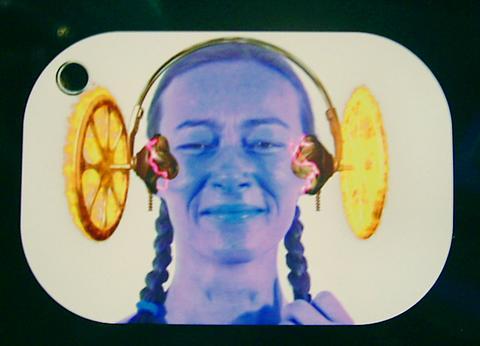The Museum of Contemporary Art's Digital Sublime: New Masters of Universe opened up to great fanfare last weekend: dignitaries gave speeches, roaming waiters served sparkling beverages and cakes, and South Korean artist Jong Bum-choi gave a live performance of sound and light images projected on MOCA's facade. After two humongous white moon-shaped balloons were ceremoniously rolled away from the entrance, the exhibition officially opened and the huge art-going crowd poured in.
The Seoul Museum of Art curator Wonil Rhee who had previously organized Media City Seoul 2002 brought together 23 international digital artists for an exhibition consisting of computers, videos, paintings and photography that is a visual delight with a happy message. Lately we've been inundated with perversely morbid images from the political realm, so it's refreshing to see images that make us see the beauty in the world around us. In these dangerous times, a little bit of awe of creation goes a long way. However, even though the technology is complicated, the exhibition has a painterly focus and is not intensely conceptual allowing easier accessibility to the viewer.

PHOTO COURTESY OF MOCA
Lee Kyung-ho's Digital Moon installation epitomizes the show's theme of linking the Zen-like contemplation of the moon's reflected light with the unearthly glow of computer screens. Three large circles of light are projected in a room incorporating the viewer into a kaleidoscope of shapes, while slow moody music makes this a room for quiet
contemplation.
The exhibition often refers to Christian themes to tell us that a resurrection of possibilities exists at the click of a mouse. Strikingly, even though many of the displayed works are interactive, they don't seem deeply engaging but rather flat technical displays of what technology can do. You move a mouse around on a pad and you get a squiggle on a screen as in Golan Levin's Aurora &
Yellowtail and Miltos Manetas' Jacksonpollock.org.
Perhaps it is the limitation of technology as the imagery is controlled by its program and not by the user.
Digital art with sound easily crosses over into the domain of the nightclub scene. Wang Fujui's
More conceptually, Eva Stenram wittingly uses digital means to explore the semantic meanings in how we construct our world. The architectural surfaces of royal estates such as Windsor House and Balmoral House are superimposed on a block of low-income housing estates.
Some works hint at the dystopic aspects of technology. Joseph Nechvatal's Luna vOluptuary shows a computer virus slowly consuming and eating up a pain ting image. Jose Carlos Casado's riveting double-screen video installation Pandora's Box wryly shows a woman opening the infamous box online and unleashing wonderful cyber images. Will our new technologies unleash similar troubles?

Jan. 5 to Jan. 11 Of the more than 3,000km of sugar railway that once criss-crossed central and southern Taiwan, just 16.1km remain in operation today. By the time Dafydd Fell began photographing the network in earnest in 1994, it was already well past its heyday. The system had been significantly cut back, leaving behind abandoned stations, rusting rolling stock and crumbling facilities. This reduction continued during the five years of his documentation, adding urgency to his task. As passenger services had already ceased by then, Fell had to wait for the sugarcane harvest season each year, which typically ran from

It’s a good thing that 2025 is over. Yes, I fully expect we will look back on the year with nostalgia, once we have experienced this year and 2027. Traditionally at New Years much discourse is devoted to discussing what happened the previous year. Let’s have a look at what didn’t happen. Many bad things did not happen. The People’s Republic of China (PRC) did not attack Taiwan. We didn’t have a massive, destructive earthquake or drought. We didn’t have a major human pandemic. No widespread unemployment or other destructive social events. Nothing serious was done about Taiwan’s swelling birth rate catastrophe.

Words of the Year are not just interesting, they are telling. They are language and attitude barometers that measure what a country sees as important. The trending vocabulary around AI last year reveals a stark divergence in what each society notices and responds to the technological shift. For the Anglosphere it’s fatigue. For China it’s ambition. For Taiwan, it’s pragmatic vigilance. In Taiwan’s annual “representative character” vote, “recall” (罷) took the top spot with over 15,000 votes, followed closely by “scam” (詐). While “recall” speaks to the island’s partisan deadlock — a year defined by legislative recall campaigns and a public exhausted

In the 2010s, the Communist Party of China (CCP) began cracking down on Christian churches. Media reports said at the time that various versions of Protestant Christianity were likely the fastest growing religions in the People’s Republic of China (PRC). The crackdown was part of a campaign that in turn was part of a larger movement to bring religion under party control. For the Protestant churches, “the government’s aim has been to force all churches into the state-controlled organization,” according to a 2023 article in Christianity Today. That piece was centered on Wang Yi (王怡), the fiery, charismatic pastor of the